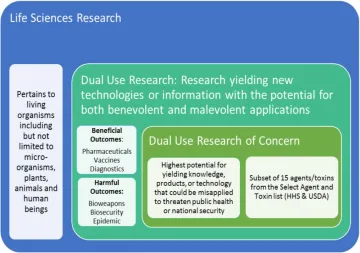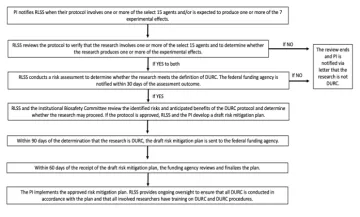DURC is defined by the U.S. Government as:
“life sciences research that, based on current understanding, can be reasonably anticipated to provide knowledge, information, products, or technologies that could be directly misapplied to pose a significant threat with broad potential consequences to public health and safety, agricultural crops and other plants, animals, the environment, material, or national security.”

The “United States Government Policy for Oversight of Life Sciences Dual Use Research of Concern,” issued in 2012, requires federal funding agencies to review research, identify projects and proposals that qualify as DURC, and verify that appropriate risk-reducing measures are in place.
The “United States Government Policy for Institutional Oversight of Life Sciences DURC,” issued in 2014, explains the institutional-level policies, practices, and procedures for the identification and risk mitigation of DURC.
Under DURC policies, research that involves one of the following 15 agents or toxins and produces/is anticipated to produce one of the following 7 experimental effects requires DURC review.
| Agents/Toxins | |
|---|---|
|
1 |
Avian influenza virus (highly pathogenic) |
|
2 |
Bacillus anthracis |
|
3 |
Botulinum neurotoxin |
|
4 |
Burkholderia mallei |
|
5 |
Burkholderia pseudomallei |
|
6 |
Ebola virus |
|
7 |
Foot-and-mouth disease virus |
|
8 |
Francisella tularensis |
|
9 |
Marburg virus |
|
10 |
Reconstructed 1918 influenza virus |
|
11 |
Rinderpest virus |
|
12 |
Toxin-producing strains of Clostridium botulinum |
|
13 |
Variola major virus |
|
14 |
Variola minor virus |
| 15 | Yersinia pestis |
|
In addition to these agents/toxins and experiment categories, institutions have the ability to use their discretion to determine if other types of life sciences constitute DURC.
DURC at the University of Arizona
If a PI is conducting research that involves one or more of the 15 select agents or toxins or may produce one or more of the 7 experimental effects, then they must complete the DURC Review Application Form (below) and email it to rlss-bio-support@email.arizona.edu. The following process will ensue.

Compliance with federal DURC policies is imperative. Lack of compliance may result in the loss or suspension of federal funding for the research in question and loss of future funding opportunities for life sciences research at the University of Arizona.

